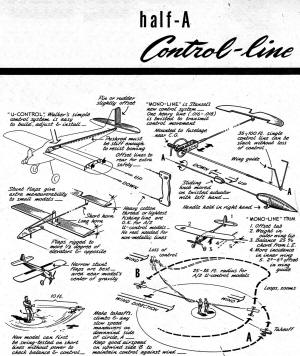|
Half-A
(aka 1/2A, 1/2-A, and A/2) control
line flying has been a staple of the model airplane hobby for at
least 3/4 of a century. Because of the relative low cost and low
complexity of the engine, airframe, and fuel consumption, 1/2-A
has been the entry point for untold thousands of kids and adults
- an 'entry drug' of sorts because many of those people, myself
included, get 'hooked' and move on to bigger
(but not necessarily better) things
as the years and decades go by. The well-known Cox
(L.M.
Cox Manufacturing) ready-to-fly plastic models are no
longer produced, but some of the .049 engine parts and even some
full engines can still be purchased both on eBay and from the Canadian
company, Cox International,
who bought the remaining stock of Cox components a few years back.
They are also selling collector-quality vintage engines still in
the original packages. Anyway, this article from a 1951 edition
of Air Trails provides a primer on 1/2-A modeling. Half-A
Control-Line
Adjusting flying tips and model improvements especially for the
novice flyer. Tell us what other subjects you would like covered.

Though the intriguing Half-A control-line models are leaders
in popularity, particularly among beginners in modeling, they are
not without their shortcomings. With engine displacement reduced
to a small fraction of the size we have been accustomed to in the
past (a Half-A engine is only one-twelfth the displacement of a
Class D .60 engine!) there is a corresponding reduction in power.
The smaller, lighter ships that result are more at the mercy of
the winds than the larger ones and have little of the very "solid"
feel we associate with larger, more powerful control jobs. An inexperienced
modeler with a new Half-A control ship is wise to wait for calm
weather. Follow the wind diagram carefully for proper operation.

Jim Walker's "U-Control" and the new Stanzel "Mono-Line" are
the control systems in use nowadays. U-Control, with its inherent
simplicity, is foolproof; it utilizes two tether lines to handle,
movements of which are transmitted to a pivoted bellcrank, thence
to hinged elevator. The lines must be kept taut, however, and such
methods as outward offset engine thrust line, outward offset rudder
tab, weight in outer wing tip, more incidence in inner wing panel,
and rearward location of control line wing guides are resorted to
in various combinations to maintain line tension. These many "tools"
can be used to extreme, causing a crabbing flight attitude which
is neither efficient nor desirable. An untested model should incorporate
perhaps two of these wrinkles for a safe test flight; reduce them
as much as the flight attitude indicates you can get by with.
Half-A models can be flown on very lightest casting line or heavy
commercial cotton thread. Only the lightest wire lines need be used.
Heavy threads can be wrapped around the handle, while metal lines
require use of a reel to prevent kinking or curling.
Mono-Line flying presents two outstanding advantages: longer
lines can be used-up to 100 ft. radius - and full control is maintained
even if the line should become slack. When short lines are used,
.016" dia. steel wire is specified, and when length is increased
to 100 ft., the diameter is increased to .018". Smaller or larger
sizes of wire affect control; don't use stranded or braided "cables."
It is best to balance U-Control models fairly nose-heavy, somewhere
near the wing leading edge. Mono-Line ships should balance about
25% of chord from leading edge. Selection of woods, type and extent
of paint job, wheels, propellers, etc. affect balance greatly. Improper
balance of a finished model can often be corrected with lead weights.
Posted May 17, 2015
|